|

Reference Guide
|
|
Using the Printer Driver / For Macintosh
Mac OS 8.6 to 9.x Users
 Installing the printer driver
Installing the printer driver
 Selecting the printer driver
Selecting the printer driver
 Printer driver settings
Printer driver settings
 Installing the PostScript printer driver (EPL-6200 only)
Installing the PostScript printer driver (EPL-6200 only)
 Selecting the PostScript printer driver
Selecting the PostScript printer driver
 PostScript printer driver settings
PostScript printer driver settings
 Using online help
Using online help
Installing the printer driver
The printer driver is included in the CD-ROM that shipped with your printer. For instructions on installing the printer driver, see the Setup Guide.

[Top]
Selecting the printer driver
If the printer is fitted with an optional network card, select it from the Chooser as described below.
 |
Note:
|
 | |
If the printer is connected to your computer via a USB port, see the previous section entitled Setting for a USB Connection for information on how to select the printer.
|
|
 |
In the Apple menu, select Chooser. The Chooser dialog box appears.
|
 |
Make sure that AppleTalk is active.
|
 |
Click the EPL-6200 icon to select it. The name of your printer appears in the Select a Printer Port box.
|
 |
Click on the name of your printer to select it.
|
 |  |
Note:
|
 |  | |
If your computer is connected to more than one AppleTalk zone, click the AppleTalk zone your printer is connected to in the AppleTalk Zones list.
|
|
 |
Close the Chooser.
|

[Top]
Printer driver settings
To control your printer and change its settings, use the printer driver. The printer driver allows you to easily make all the print settings, including paper source, paper size, and orientation. To access the driver menus, see below.
To access the printer driver from Mac OS 8.6 to 9.x, Choose Chooser from the Apple menu. Then click the EPL-6200 icon and click Setup.
-
To open the Paper Setting dialog box, select Page Setup from the File menu on any application.
-
To open the Basic Settings dialog box, select Print from the File menu on any application.
-
To open the Layout dialog box, click the layout icon on the Basic Settings dialog box.
Choosing the print quality (EPL-6200 only)
 |
Note:
|
 | |
The print quality setting for the EPL-6200L cannot be changed. It prints at 600 dpi only.
|
|
You can change the print quality or resolution of printouts to favor speed or detail. If you need high quality output, choose a higher number. Please note that doing so reduces the print speed.
There are three levels of print output, 600 dpi, Class 1200 dpi, and 1200 dpi. Class 1200 dpi provides high quality printing results on par with 1200 dpi with the Enh.MG and RITech functions (under 600 dpi).
 |
Open the Basic Settings dialog box.
|
 |
Select Automatic on Print Quality, and select the desired printing resolution from the Resolution drop-down list.
|
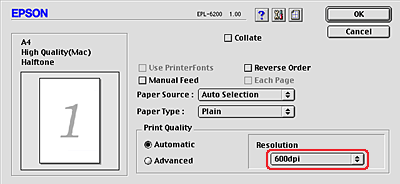
 |  |
Note:
|
 |  | -
If printing is unsuccessful or a memory-related error message appears, selecting a lower resolution may allow printing to proceed.
|
|
 |  | -
For details of the Enh.MG or RITech functions, see the Online Help.
|
|
Resizing printouts
The Fit to page function in the Layout dialog box allows you to have your documents enlarged or reduced during printing according to the specified paper size.
 |
Note:
|
 | -
The enlarging or reducing rate is automatically specified according to the paper size selected in the Paper Setting dialog box.
|
|
 | -
The modifying or reducing rate selected in the Paper Setting dialog box is not available.
|
|
 |
Open the Layout dialog box.
|
 |
Select the Fit to Page check box.
|
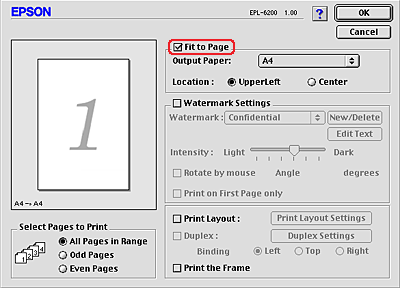
 |
Select the desired paper size from the Output Paper drop-down list. The page will be printed to fit on the paper you have selected.
|
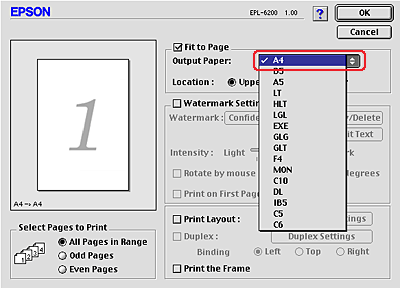
 |
Click OK to accept settings.
|
Modifying the print layout
"Layout printing" prints either two or four pages onto a single page and to specify the printing order, automatically resizing each page to fit the specified paper size. You can also choose to print documents surrounded by a frame.
 |
Open the Layout dialog box.
|
 |
Select the Print Layout check box, then click Print Layout Settings. The Print Layout Settings dialog box appears.
|
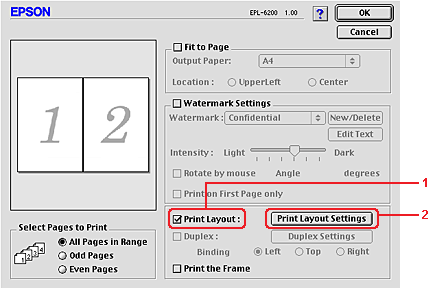
 |
Select the number of pages you want to print on one sheet of paper.
|
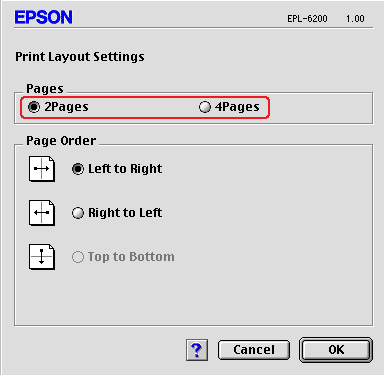
 |
Select the page order in which the pages are printed on each sheet.
|
 |  |
Note:
|
 |  | |
Page Order choices depend on Pages selected in Orientation.
|
|
 |
Click OK to close the Print Layout Settings dialog box.
|
 |
Select the Print the Frame check box in the Layout dialog box when you want to print the pages surrounded by a frame.
|
 |
Click OK in the Layout dialog box to accept the settings.
|
Using watermarks
Follow the steps to use a watermark on your document. In the Layout dialog box, you can select from a list of predefined watermarks, or you can select a bitmap (PICT) file or a text file as your own custom watermark. The Layout dialog box also allows you to make a variety of detailed watermark settings. For example, you can select the size, intensity, and position of your watermark.
 |
Open the Layout dialog box.
|
 |
Select the Watermark Settings check box.
|
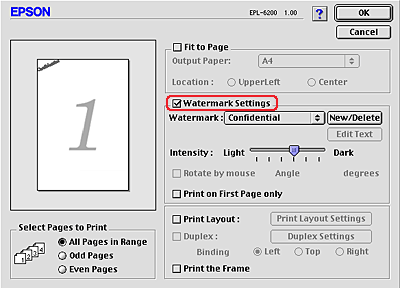
 |
Select a watermark from the Watermark drop-down list.
|
 |
Select the location on the page where you want to print the watermark by dragging the watermark image on the preview window. Also, when you want to resize the watermark, drag its handle.
|
 |
Adjust the image intensity of the watermark with the Intensity slider bar.
|
 |
For a text watermark, you can rotate it by entering the degrees in the Angle box. Or, select the Rotate by mouse check box, and rotate the text watermark with the pointer on the preview window.
|
 |
Click OK to accept the settings.
|
Making a new watermark
To make a text watermark, follow the instructions below:
 |
Open the Layout dialog box.
|
 |
Select the Watermark Settings check box.
|
 |
Click New/Delete.
|
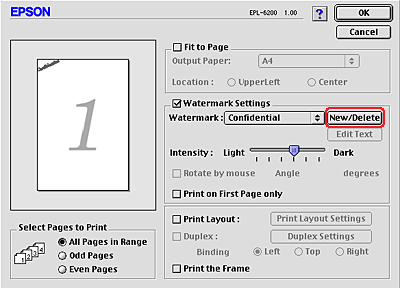
 |
Click Add Text.
|
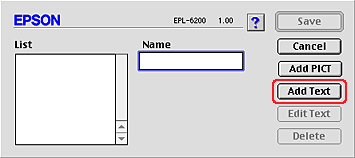
 |
Type the watermark text in the Text box, select the Font and Style, and then click OK.
|
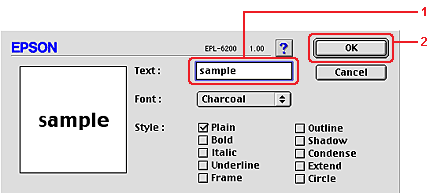
 |
Type the desired name for the watermark in the Name box, and then click Save.
|
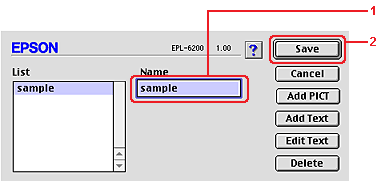
 |  |
Note:
|
 |  | |
To edit the saved text watermark, select it from List, and click Edit Text. After editing, be sure to click OK to close the dialog box.
|
|
 |
Click OK on the Layout dialog box.
|
 |
Note:
|
 | |
To edit the saved text watermark, select it from the List, and click Edit Text in step 4 above.
|
|
To make a bitmap watermark, follow the instructions below:
 |
Note:
|
 | |
Before making a custom watermark, you should prepare a bitmap (PICT) file.
|
|
 |
Open the Layout dialog box.
|
 |
Select the Watermark Settings check box.
|
 |
Click New/Delete.
|
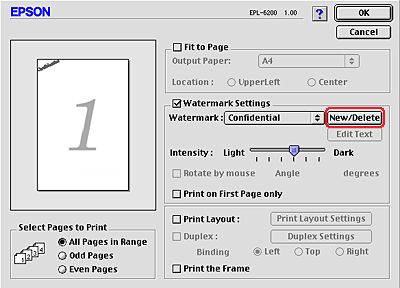
 |
Click Add PICT.
|
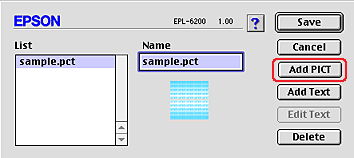
 |
Select the PICT file and click Open. When you click Create, the watermark is displayed on the preview window.
|
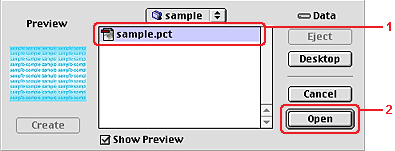
 |
Type the desired name for the watermark in the Name box, and then click Save.
|
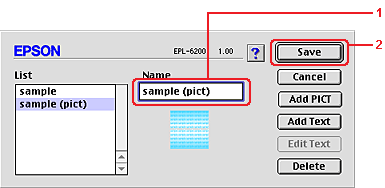
 |  |
Note:
|
 |  | |
To edit the saved text watermark, select it from List, and click Edit Text. After editing, be sure to click OK to close the dialog box.
|
|
 |
Click OK on the Layout dialog box.
|
 |
Note:
|
 | |
To edit the saved text watermark, select it from the List, and click Edit Text in step 4 above.
|
|
Printing with the Duplex Unit (EPL-6200 only)
Duplex printing prints on both sides of the paper. When printing for binding, the binding edge can be specified as required to produce the desired page order.
 |
Click the Layout icon on the Basic Settings dialog box. The Layout dialog box appears.
|
 |
Select the Duplex check box.
|
 |
Select a Binding position from Left, Top, or Right.
|
 |
Click Duplex Settings to open the Duplex Settings dialog box.
|
 |
Specify the Binding Margin for the front and back sides of the paper.
|
 |
Select whether the front or back side of the paper is to be printed as the Start Page.
|
 |
Click OK to accept the settings and return to the Layout dialog box.
|
Avoiding Insufficient Memory Error (EPL-6200L only)
When you print graphics or a large amount of data, the printer may stop due to insufficient memory. Follow the steps below to avoid memory errors and continue printing.
 |
Note:
|
 | |
Print quality will decrease when you use this function.
|
|
 |
Click the Extended Settings icon on the Basic Settings dialog box.
|
 |
Select the Avoid Insufficient Memory Error check box.
|
 |
Click OK to accept the settings.
|

[Top]
Installing the PostScript printer driver (EPL-6200 only)
To print files in the Adobe PostScript 3 format in Mac OS 8.6 to 9.x and Mac OS X, version 10.2.x, you will have to install the PostScript printer driver and screen fonts that are included in the CD-ROM that shipped with your printer. See the appropriate sections below for installation instructions according to the operating system that you are using.
The Installer program that is included in the CD-ROM that shipped with your printer installs the PostScript driver and the screen fonts. Before installing the printer driver, make sure that your hard disk has at least 3.1 MB of free space.
The installer program has two installation methods: Easy Install and Custom Install.
Easy Install installs all the necessary files. Normally, you should use the Easy Install method since this ensures that all necessary files are copied and that your computer is set up to give you the full benefit.
Custom Install installs only the files that you specify. You might want to use the Custom Install method if you are low on hard disk space and want to install only those files that are absolutely required. However, if you have enough free disk space, it is recommended that you choose the Easy Install method.
Easy Install
If your Macintosh starts up any applications automatically (such as a virus checker) when the computer is turned on, quit the applications before running the Installer.
Follow the steps below to install the printer driver:
 |
Turn on your Macintosh if it is not already on.
|
 |
Insert the CD-ROM that shipped with the printer into your CD-ROM drive.
|
 |
Double-click the CD-ROM icon, and then double-click English.
|
 |
Double-click AdobePS 8.7, and then double-click AdobePS Installer.
|
 |
Follow the on-screen instructions until the install screen is displayed.
|
 |
Select Easy Install, and then click Install.
|
 |  |
Note:
|
 |  | |
Only the Easy Install option is available when installing the printer driver for the EPL-6200L.
|
|
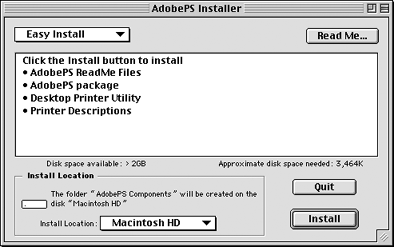
 |
When installation is done, click Restart to restart your computer.
|
This completes the installation of the printer driver. You now need to select the printer driver as described in the next section.
If you are connecting two or more EPSON printers of the same model using AppleTalk, and you want to rename the printer, see the Administrator's Guide that shipped with the printer.
Custom Install (EPL-6200 only)
If your Macintosh starts up any applications automatically (such as a virus checker) when the computer is turned on, quit the applications before running the Installer.
To perform a Custom Install, in which you specify which files to install, follow steps 1 to 5 of the Easy Install method (see previous section), and then do the following:
 |
Select Custom Install.
|
 |
Select the item(s) that you want to install.
|
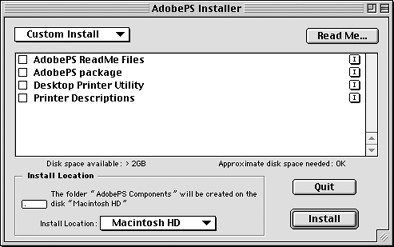
 |  |
Note:
|
 |  |
If you want information on a particular item, click the  icon to the right of that item. icon to the right of that item.
|
|
 |
Click Install.
|
 |
When installation is done, click Quit.
|
 |
Restart your computer.
|
This completes the installation of the printer software. You now need to select the printer driver as described in the next section.
If you are not able to print after a Custom Install, perform the Easy Install installation to copy all necessary files to your computer.
If you are connecting two or more printers of the same model using AppleTalk, and you want to rename the printer, see the Administrator's Guide that shipped with the printer.

[Top]
Selecting the PostScript printer driver
If the printer is fitted with an optional network card, select it from the Chooser as described below.
 |
Note:
|
 | |
If the printer is connected to your computer via a USB port, see the previous section entitled Setting for a USB Connection for information on how to select the printer.
|
|
 |
In the Apple menu, select Chooser. The Chooser dialog box appears.
|
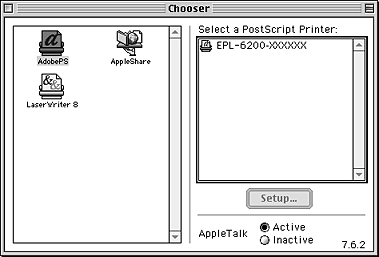
 |
Make sure that AppleTalk is active.
|
 |
Click the AdobePS icon to select it. The name of your printer appears in the Select a PostScript Printer box.
|
 |  |
Note:
|
 |  | |
By default, the six-digit MAC address is displayed after the printer name. Refer to your network card manual for details.
|
|
 |
Click on the name of your printer to select it. The Create button appears.
|
 |  |
Note:
|
 |  | |
If your computer is connected to more than one AppleTalk zone, click the AppleTalk zone your printer is connected to in the AppleTalk Zones list.
|
|
 |
Click Create.
|
A message will appear marking the completion of the setup. The Chooser dialog box will be displayed again. (The Create button changes into the Setup button.)
To confirm that the setup completed successfully, click Setup in the Chooser dialog box, and then click Printer Info and Configure to check the settings.
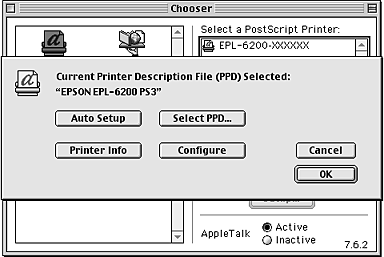
If the setup did not complete successfully, follow the steps below:
 |
Return to the dialog box shown above.
|
 |
Click Select PPD. The PPD selection dialog box will be displayed.
|
 |
Select EPL-6200 PS3, and then click Select.
|
If you need to cancel the installation of the PPD you selected, click Cancel. To try to setup the printer again, repeat step 5 above.
 |
Note:
|
 | |
If QuickDrawGX is installed, you must turn it off in the Extensions Manager before you can use the Adobe PostScript printer driver.
|
|

[Top]
PostScript printer driver settings
The printer driver enables you to change the settings for your print job. The printer driver settings can be accessed through the Page Setup and Print dialog boxes of the application that you are printing from. The various settings are grouped under the Page Setup and Print dialog boxes in the following manner:
-
Page Setup dialog box: Settings that affect the attributes of the page to be printed, such as the paper size, orientation, and margins are available here.
-
Print dialog box: All other print settings, such as the paper source, resolution, and other PostScript settings are available here.
The actual settings that are available might vary, depending on your application.
Page Setup dialog box
When you select Page Setup in the File menu of your application, the dialog box shown below appears. The dialog box you see might be slightly different, depending on your application. There are four setup option pages in this dialog box: Page Attributes, Watermark, PostScript Options, and Custom Page Default.
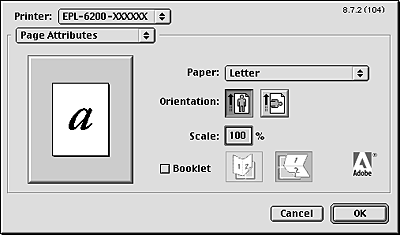
The settings and the buttons that appear in the Page Setup dialog box are explained below.
Cancel
Click this button to exit the dialog box without saving any changes you made.
Page Attributes
Paper
Select the desired paper size from the Paper pop-up menu. This setting must match the size of the paper loaded in the printer. The paper sizes that are available will differ according to the printer. The default setting is either A4 or Letter, depending on your country of purchase.
Orientation
Specify whether the page is to be printed in the portrait (vertical) or landscape (horizontal) orientation.
Scale
This setting enables you to shrink or enlarge the image to print. You can enter any percentage from 25% to 400%. The default is 100%. To shrink the image, specify a percentage that is lower than 100%. To enlarge the image, specify a percentage that is higher than 100%. However, if you can shrink or enlarge the image to print in the application that you are printing from, do so in the application and not through the printer driver.
Booklet
Select this check box to print out two document pages on a single sheet of paper. When the sheet is folded in half, it will form a booklet. You can set the page orientation for either left-right or top-bottom folds.
Watermark
None
This radio button is selected by default, and indicates that your print job will be printed without any watermark.
First
Select this radio button if you want the selected watermark to be printed only on the first page of your document.
All
Select this radio button if you want the selected watermark to be printed on all the pages of your document.
PICT
Select this radio button to show all available watermarks in the PICT format under the Watermark pop-up menu.
EPS
Select this radio button to show all available watermarks in the EPS format under the Watermark pop-up menu.
TEXT
Select this radio button to show all available watermarks in the TEXT format under the Watermark pop-up menu.
Foreground
Select this check box if you want the selected watermark to be printed in the foreground, i.e., over the document's text and/or graphics.
Save With Document
Select this check box if you want to save the watermark with the document for future printing.
Edit
Click this button to modify the contents of the selected watermark. Only watermarks in the TEXT format can be modified. This button is available only when the TEXT radio button is selected.
PostScript Options
Visual Effects
Flip Horizontal
Select this check box to flip the printed image horizontally on the page.
Flip Vertical
Select this check box to flip the printed image vertically on the page.
Invert Image
Select this check box to invert the image or text on the page so that black areas of the page become white and white areas become black.
Image and Text
Substitute Fonts
Select this check box to allow the printer to use substitute fonts during printing.
Smooth Text
Select this check box to improve the appearance of bitmap fonts.
Smooth Graphics
Select this check box to improve the appearance of printed graphics by smoothing jagged edges.
Precision Bitmap Alignment
Select this check box to reduce the printed document to correct for distortions that sometimes occur in printed bitmap graphics.
Unlimited Downloadable Fonts
Select this check box when using a large number of downloadable fonts in a document. This setting may slow down printing.
Custom Page Default
Units
Select the desired unit that you want to work in when customizing the page. The options are cm, inches, and pts.
Paper size pop-up menu
This pop-up menu automatically shows the paper size that is selected on the Page Attributes setup page. You can change the paper size by clicking on the menu and selecting the desired paper size to customize.
Paper Size
Enter the desired Width, Height, and Offset values for the custom page.
PPD Limits
Click the pop-up menu and select the various attributes to view the minimum and maximum values permitted by the selected PPD (PostScript Printer Description) file.
Margins
Specify the desired Top, Bottom, Left, and Right margin values.
Custom Page Name
Enter a name for the custom page that you are creating.
Remove
Click to delete the custom page selected in the paper size pop-up menu. This button is grayed out when a non-custom paper size is selected.
Add
Click to add the custom page that you are creating onto the list of selectable paper sizes. This button is grayed out if nothing is entered into the Custom Page Name text box.
Print dialog box
When you select Print in the File menu of your application, the dialog box shown below appears. The dialog box you see might be slightly different, depending on your application. There are eight setup option pages in this dialog box: General, Background Printing, Cover Page, Color Matching, Layout, Error Handling, PostScript Settings, and Printer Setting.
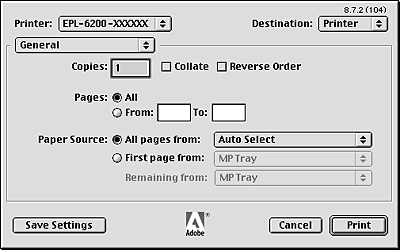
The settings and the buttons that appear in the Print dialog box are explained below.
Cancel
Click this button to exit the dialog box without saving any changes you made.
Save Settings
Click this button to save changes to the settings. Until you make additional changes and click this button again, the changes saved will be used as the default settings for this printer.
General
Copies
Specify how many copies of the document to print. Enter any number from 1 (default) to 32,000. Select the Collate option when printing multiple copies of a multi-page document, so that each document copy will be printed out with the page in order. Select the Reverse Order option to print the document with the pages in reverse order (i.e., starting with the last page).
Reverse Order
Select this check box to reverse the print order.
Pages
All
Select this radio button to print out all the pages of the document.
From, To
Specify the range of pages to print. The available numbers are 1 to 32,000.
Paper Source
All pages from
Select the paper source for your print job. The options are Auto Select, MP Tray, Cassette 1, Cassette 2, Cassette 3, and Manual Feed. However, the actual paper sources that are available will differ according to the printer and the options installed.
First page from
Select the paper source for printing the first page of the document.
Remaining from
Select the paper source for printing the rest of the document after the first page.
 |
Note:
|
 | -
Cassette 2 and Cassette 3 can be selected only if the corresponding optional cassette unit is installed on your printer.
|
|
 | -
If you are printing on a custom paper size created under the Custom Page Default setup option page on the Page Setup dialog box, the paper must be fed from the MP Tray. Only the Auto Select and the MP Tray options can be selected.
|
|
Background Printing
Print in
Foreground (no spool file)
Select this radio button to print the document in the foreground. When this is selected, you cannot use your computer for other operations while printing.
Background
Select this radio button to print the document in the background. When this radio button is selected, you can use your computer for other operations while printing.
Print Time
Urgent
Select this radio button to give the document first priority among the print jobs in the print queue.
Normal
Select this radio button to place the document in the print queue in the order received.
Print at
Select this radio button to specify a date and time to print the document.
Put Document on Hold
Select this radio button to keep the document in the print queue without printing it.
Cover Page
Print Cover Page
None
Select this radio button if you do not want to print a cover page.
Before Document
Select this radio button to print the cover page as the first page of the document.
After Document
Select this radio button to print the cover page as the last page of the document.
Cover Page Paper Source
Select the paper source for the printing of the cover page. The options are Same as document, MP Tray, Cassette 1, Cassette 2, and Cassette 3. However, the actual paper sources that are available will differ according to the printer and the options installed.
 |
Note:
|
 | |
Cassette 2 and Cassette 3 can be selected only if the corresponding optional cassette unit is installed on your printer.
|
|
Color Matching
Print Color
Specify whether the document is to be printed in color or grayscale. The options are: Black and White and Color/Grayscale. When Black and White is selected, printing is compatible with the Apple LaserWriter 7.x.
Layout
Pages per sheet
Specify how many pages of your document to print on one sheet of paper.
Layout direction
Specify whether the document should be laid out from left to right or right to left.
Border
Specify whether the document prints with a border around the edges of the page. The options are none, Single hairline, Single thin line, Double hairline, and Double thin line.
Print on Both Sides
Select this check box to print on both sides of the paper.
 |
Note:
|
 | |
This check box may appear even when the optional Duplex Unit is not installed. However, you will not be able to use this function.
|
|
Error Handling
If there is a PostScript error:
No special reporting
When this radio button is selected, PostScript errors will not be reported.
Summarize on screen
When this radio button is selected, a summary of the PostScript errors will be displayed on the screen.
Print detailed report
When this radio button is selected, a detailed report of the PostScript errors will be printed.
PostScript Settings
Format
Select the file format that you want the new file to have. The options are PostScript Job, EPS Mac Standard Preview, EPS Mac Enhanced Preview, and EPS No Preview.
PostScript Level
Select the PostScript compatibility level for the PostScript file that contains a description of your document. The options are Level 1, 2 and 3 Compatible, Level 2 Only, and Level 3 Only.
Data Format
ASCII
Select this radio button if you plan to later edit the document. The file will be saved as an ASCII or text file.
Binary
Select this radio button to save the file as a binary file. Binary files are typically smaller in size than ASCII files.
Font inclusion
Specify the type of fonts to include in the file. The options are None, All, All But Standard 13, and All But Fonts in PPD file.
Print Setting
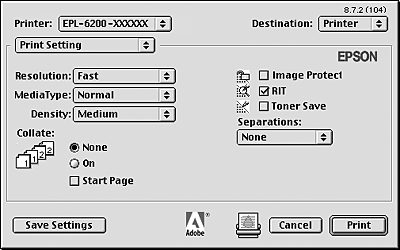
Resolution
Select the resolution that you want to print in. The options are Fast and Quality. The Quality setting prints at a higher resolution, but the printing time will be longer.
MediaType
Select the desired paper type to print on. The options are Normal, Thick, Extra Thick, and Transparency. Make sure to select the correct paper type to avoid smearing or wasting ink.
Density
Specify the density to print in. The options are Lightest, Light, Medium, Dark, and Darkest.
Collate
Select the On radio button to print multiple copies of the document in page order. If None is selected, each page is printed out the specified number of times before the following page is printed.
 |
Note:
|
 | |
If you enable the Collate option here (On is selected), do not set the Collate option in the application itself.
|
|
Start Page
Select this check box to start printing from the second (back) page, leaving the first page blank. This setting is enabled only when the Print on Both Sides check box on the Layout setup option page is selected.
Image Protect
Select this check box to give priority to the quality of the printed image. When this is selected, lossy compression is not used even when memory runs low during printing. If this check box is left unselected, lossy compression is used when memory resources are too low.
RITech
Select this check box to use RITech when printing. RITech improves the appearance of printed lines, text, and graphics.
Toner Save
Select this check box to use the Toner Save feature when printing. When the Toner Save feature is turned on, the printer uses about 50% less toner than normal.
Separations
This setting enables you to select the color for separation printing. The options are None, Cyan, Magenta, Yellow, and Black.

[Top]
Using online help
You can access the Online Help from the printer driver. The Online Help provides you with detailed information and instructions on the printer driver that controls your printer. It is automatically installed when you install the printer driver.
Balloon Help is available to help you with the printer driver settings. Follow the steps below to use Balloon Help when the Print or Page Setup dialog box is displayed:
 |
Click the Help menu, and then select Show Balloons.
|
 |
Place your cursor over the item that you need help with. Information on that item is displayed inside a floating balloon.
|
To end Balloon Help, click the Help menu, and then select Hide Balloons.

[Top]
| Version NPD2540-00, Copyright © 2008, SEIKO EPSON CORPORATION |
Installing the printer driver
Selecting the printer driver
Printer driver settings
Installing the PostScript printer driver (EPL-6200 only)
Selecting the PostScript printer driver
PostScript printer driver settings
Using online help